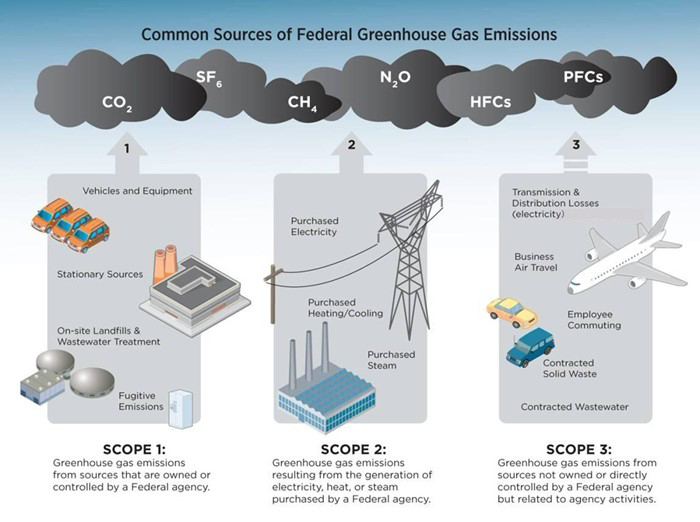Greenhouse Gas Emission Scopes
The matching YouTube for this article is located at the Greenhouse Gas Emissions Scopes video.
Many companies in the energy and process industries have committed to a Net Zero program. Their aim is to cease net emissions of greenhouse gases by a specific year, often 2050. In order to properly define their goal these companies need to identify the emissions for which they are responsible.
The U.S. Environmental Protection Agency (EPA) has published information to do with the “scopes” or types of emission, as shown in the following image.

The black clouds as the top of the image show the emitted chemicals that contribute toward the greenhouse effect. The first one shown in carbon dioxide (CO2). This is the chemical that receives the most attention in climate change discussions. But there are others. For example, methane (CH4) is around fifty times more potent than CO2 and is emitted in significant amounts from many of the operations of oil companies.
EPA Scopes
The EPA defines three “scopes” or types of emission for which the agency itself is responsible. Their definitions can be applied to other organizations and companies.
Although these definitions are useful and important, they are only a starting point, and they generate many follow on questions. The devil resides in his usual location. For example, Scope 3 emissions cover transportation. Is a chemical company that receives supplies from another company responsible for the emissions from the trucks that are used? Or should the vendor company replace its diesel trucks with electric vehicles as part of its own greenhouse gas reduction program?
Another problem is to do with available technology. It is well and good to say that diesel trucks should be replaced with electrically powered replacements. But electric trucks are not commercially available, and are not likely to be for many years.
And, as always, the final question becomes, “Who pays?”
Scope 1 Emissions
These are the emissions for which the company is directly responsible. For example, if a refinery or chemical plant has a gas-fired boiler that generates steam and electrical power then the carbon dioxide emissions from that boiler are the company’s responsibility and will have to be eliminated. The company will have to generate the steam and electricity it uses from a renewable source of energy.
Similarly, a company is probably responsible for the emissions of the vehicles that it owns and operates. These vehicles will have to be converted to electric power, and the batteries in the vehicle will have to be charged from a renewable source of electricity.
Scope 2 Emissions
These are indirect emissions that result from a company’s activities. For companies in the process industries the principle sources of Scope 2 emissions are the external utilities that provide steam and electricity.
Scope 3 Emissions
These emissions come from activities that are indirectly related to a company’s work. Examples are employee travel and commuting, the disposal of effluents, and transportation costs.
Chain of Responsibility
For Scopes 2 and 3 the chain of responsibility can be difficult to define, as we have seen with regard to the emissions of a vehicle that delivers a product from one company to another. Another example would be a chemical company that purchases naphtha from a refinery. Is that chemical company responsible for the emissions created in the production of that naphtha? Or is the refinery responsible for the naphtha-related emissions?
A bigger question for oil companies is to do with emissions from the products that it sells. If a refinery manufactures diesel fuel that is then burned in the trucks of one of its customers, is the refinery responsible for the resulting emissions? Or does this responsibility reside with the company that owns the trucks?
None of this is easy — there is a lot to think about.
Cost
The implementation of environmental and safety programs is costly. A company that makes a commitment to those programs is at a competitive disadvantage to one that does not. This understanding applies to the responsibility for emissions to do with Net Zero programs.
The only way to level the playing field is to implement regulations that require companies to meet uniform standards. If a company decides to implement these standards on its own then it will lose out to other companies that do not. This means that regulations are required. And the regulations need to apply world-wide. At present there are few indications that scope-related regulations of this type are even being drafted, let alone implemented.
The Carbon Pulse
The above discussion to do with emission scopes omits consideration of a critical issue: the “carbon pulse”, i.e., the greenhouse gases that are created in the transition process. For example, a company may decide to replace its gas-fired boiler with one that uses electricity from renewable sources. But the act of manufacturing the new boiler, installing new electrical transmission lines, adding generating capacity, transporting construction materials to the site, and disposing of the old boiler are activities that all require a large expenditure of energy. Most of that energy will come from existing fossil fuel. So, the act of solving the problem, makes the problem worse, at least in the short term.

The picture shows just one part of a typical oil refinery. The challenge to do with replacing much of this equipment in just a few short years is formidable.
Need for Standards
If companies in the energy and process industries are to make a commitment to Net Zero goals then they need guidance as to which of their activities are to be included. At the time of writing (August 2021) there is some limited guidance. However, as the above discussion shows, such guidance is not detailed enough. Nor is it being applied equitably. Moreover, there are few indications that world-wide regulations are in the offing. Yet, if we are to meet Net Zero goals by the year 2050, time is pressing. It is not enough for organizations such as the IPCC to tell us about climate change problems. Detailed guidance for engineering and project management standards is needed.

Copyright © Sutton Technical Books. All Rights Reserved. 2021.
